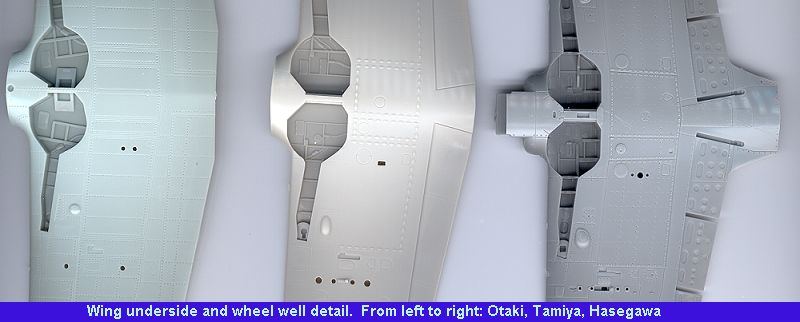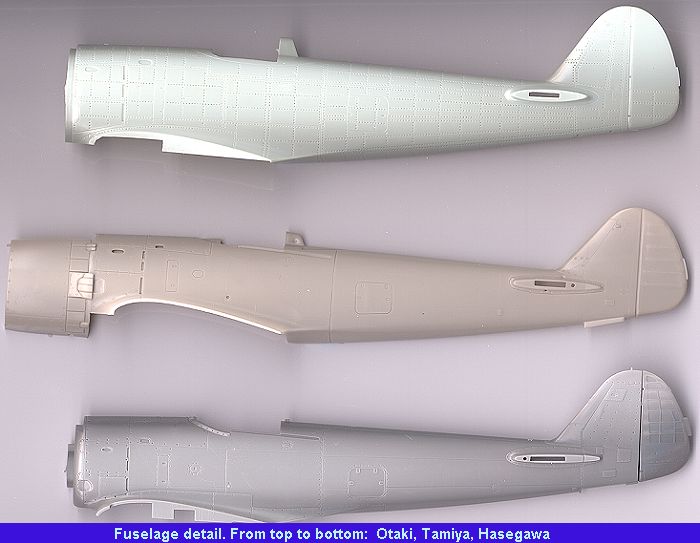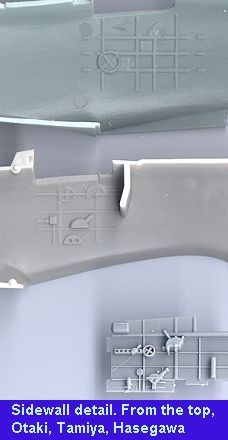
|
KITS: |
Tamiya, Otaki (ARII), & Hasegawa 1/48 Ki-84 |
|
KIT # |
MA113, 7, & JT 67 |
|
PRICE: |
$12.00, @$11.00, &$21.00 |
|
DECALS: |
See Writeups |
|
REVIEW BY: |
|
|
NOTES: |

|
BRIEF HISTORY |
Briefly, the Ki-84 'Frank' was probably the best Japanese Army fighter of the Second World War. Built in relatively small numbers compared to other aircraft, it was nonetheless fast, well armed and well armored. It suffered from engine and quality control problems, but when functioning well, it was difficult to defeat. First seen in the Philippines and China in mid 1944, it was used quite a bit by home units to tackle B-29 and Navy carrier raids.
|
THE KITS |
For 25+ years, there have been two available kits of the Ki-84 'Frank' for 1/48 aircraft builders. One by Otaki, and one by Tamiya. Granted, the Tamiya kit, though listed as 1/48 is actually 1/50. Both of these kits have sold rather well and both were considered to be the pinnacle of molding during their day. Frankly (no pun intended) both still hold up rather well, despite their age. This is probably why there has been no new kit to replace them, unlike the plethora of 109s, Spitfires, and P-51s that have invaded the hobby shelves in the past ten years.
Obviously someone at Hasegawa decided it was time for a new Ki-84 kit and so we have a brand new Frank to add to our shelves. So, how much of an improvement is it over the older kits? Is it worth the time, and tooling? Finally, is it worth your spending the money on this new kit when the others can be had for half the price? Well, to answer those and other questions, the best thing to do is to compare the three kits.

First of all the Otaki kit. First thing that strikes you are all the sunken rivets all over the airframe. Seems a bit overdone until you look at closeup photos of the Frank. What one sees are sunken rivets all over the airframe! Other 'modern' touches are full wheelwells and detail in them, and a rather complete cockpit with sidewall detail as well as fore and aft cockpit detail. One also gets a pilot, though mine had a rather large sink mark in his back!! The detail isn't as fine and delicate as what comes with today's kits, but not bad at all. Also included are a complete engine and a set of drop tanks. The canopy is molded in the closed position. Control surfaces are either very smooth or have rivet details. landing gear and wheels are rather plain with little extra detail. There are also a lot of ejector pin marks, but most are on the back side of parts or relatively easily removed. There are decals for three versions as well as a sheet with two large color profiles.
|
Here's where Otaki got the rivets! |
This drawing shows where Tamiya got their detailing info. |
Now on to the equally ancient Tamiya kit. While listed as 1/48 it really is 1/50 and comparing parts with the other kits shows that it is indeed smaller. Except for wingspan. Unlike the Otaki kit, there is no plethora of rivet detail. In fact, except for some rather obvious snaplocks under the wings, the fuselage is relatively smooth. There are an equal number of raised and engraved panel lines. Those that are engraved are in areas of the airframe where there are access panels, just like on real aircraft. There is good cockpit detail, though not as nice as the Otaki kit. Wheelwell detail is also there and a bit nicer than the Otaki kit. This pilot has two large holes in his back and the kit includes a standing pilot as well. The engine in this kit is a shallow fake front that shows both rows of cylinders. Canopy is a three piece affair and can be posed open. Landing gear and wheels have good detail on them. Control surfaces have a lot of detail on them and might be a bit overdone as the framework on the ailerons is plainly visible. There are fewer ejector pin marks on this kit than the Otaki one and what are there are well hidden. Also included with the kit are drop tanks and like the Otaki kit the holes for these are predrilled. Three versions are included on this decal sheet and again, like the Otaki kit, there is a sheet with two large color profiles.


Enter, the Hasegawa kit. I have compared the Tamiya and Otaki kits as they are basically siblings, being kits of the late 1960s/early 1970s. The latest from Hasegawa is all that one would expect from the premier Japanese aircraft kit maker. Looking at the overall molds, it seems that Hasegawa has chosen a combination of both. There are fine panel lines and some rivet detail as well. It truly is beautifully done. Where this kit shines is the cockpit. There are over 20 pieces in it and every knob and lever is represented. I seriously doubt if any aftermarket company will make any money on a resin or brass cockpit set for this one. Following the same trend as the other kits, the wheelwells look deep enough for the wheels and have great detailing. In addition, the flaps can be displayed in the lowered position. The engine is just a front as with the Tamiya kit, but again, the detail is just super. Frankly (no pun intended), this kit is really a superb effort on all fronts. Great control surface detail, though it looks a bit too detailed on the rudder. It is like the framework has been put over the rudder material! Like the other two kits, you have to use the drop tanks or fill in the holes for them. A nice touch is that there are plastic inserts for the landing gear as well as the prop. This way you can press fit them in after the rest of the aircraft has been painted. Decals are for two aircraft.
|
CONCLUSIONS |
Well, the Hasegawa kit is surely a superb effort. Easily the finest looking 1/48 single engined fighter that Hasegawa has ever produced. The big question is, is it worth the price? After all, it is twice as expensive as the others. If I had no other Ki-84 in my collection, I would get the Hasegawa kit. The Otaki and Tamiya kits are still super models in their own right, and make into great models for a reasonable cost.